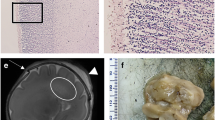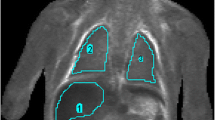We studied the possibilities of postmortem MRI for assessing the degree of maceration and determining the duration of intrauterine fetal death. Postmortem radiological and pathoanatomic study of the bodies of 38 stillbirths who died antenatally (main group, n=31) and intranatally (control group, n=5), who were born at gestational periods of 22-40 weeks was performed. Before the autopsy, MRI was performed in standard T1 and T2 modes. The tissue of the liver, kidney, brain, femoral muscle, lung, and skin in the hip, abdomen, and skull were studied on T1- and T2-weighted images (WI), followed by calculation of the of MR signal intensity ratio in T2- and T1-WI (SIR). The duration of intrauterine fetal death was determined based on the results of autopsy and analysis of histological preparations. It was found that the calculated values of SIR depended on the evaluated organ and the duration of intrauterine fetal death. Unfortunately, the revealed dynamics of changes in SIR does not allow unambiguous assessment of the severity of maceration processes and, accordingly, the time of fetal death due to its non-linear nature. Nevertheless, the use of SIR indicators of several organs and areas of the body makes it easier to determine the duration of intrauterine fetal death and, hence, to clarify the links of thanatogenesis of the stillborn. The advantages of post-mortem MRI compared to autopsy include non-invasive nature of the study, the possibility of archiving and subsequent multiple delayed analysis of tomograms, as well as the speed of MRI analysis, in contrast to microscopic stage of pathological examination associated with the need to prepare histological preparations.
Similar content being viewed by others
References
Tumanova UN, Lyapin VM, Bychenko VG, Serova NS, Shchegolev AI. Postmortem MRI characteristics of nonimmune fetal hydrops. Ross. Elektron. Zh. Luch. Diagnost. 2018;8(4):172-183. Russian.
Tumanova UN, Shchyogolev AI. Postmortem magnetic resonance tomography of fetuses and newborns. Med. Vizualization. 2015;(5):128-136. Russian.
Tumanova UN, Shchegolev AI. Radio-visualization of nonspecific postmortem changes in the cardiovascular system. Sud.-Med. Ekspertiza. 2016;59(5):59-63. Russian.
Tumanova UN, Shchegolev AI. Possibilities and limitations of virutal autopsy in neonatology. Ross. Elektron. Zh. Luch. Diagnost. 2017;7(1):20-33. Russian.
Shchegolev AI, Pavlov KA, Dubova EA, Frolova OG. Stillbirth rates in the subjects of the Russian Federation in 2010. Arkh. Patol. 2013;75(2):20-24. Russian.
Shchegolev AI, Tumanova UN, Lyapin VM. Pathological estimation of the time of fetal death. Arkh. Patol. 2017;79(6):60-65. Russian.
Arthurs OJ, Price GC, Carmichael DW, Jones R, Norman W, Taylor AM, Sebire NJ. Diffusion-weighted perinatal postmortem magnetic resonance imaging as a marker of postmortem interval. Eur. Radiol. 2015;25(5):1399-1406.
Arthurs OJ, Thayyil S, Olsen OE, Addison S, Wade A, Jones R, Norman W, Scott RJ, Robertson NJ, Taylor AM, Chitty LS, Sebire NJ, Owens CM; Magnetic Resonance Imaging Autopsy Study (MaRIAS) Collaborative Group. Diagnostic accuracy of post-mortem MRI for thoracic abnormalities in fetuses and children. Eur. Radiol. 2014;24(11):2876-2884.
Gilbert-Barness E, Spicer DE, Steffensen TS. Handbook of pediatric autopsy pathology. New York, 2014. P. 675-705.
Lally PJ, Arthurs OJ, Addison S, Sebire NJ, Alavi A, Taylor AM, Thayyil S. Can we use T2 relaxometry MRI to assess post-mortem maceration in fetuses and neonates? J. Forensic Radiol. Imag. 2014;2(2):99. https://doi.org/10.1016/j.jofri.2014.02.017
Montaldo P, Addison S, Oliveira V, Lally PJ, Taylor AM, Sebire NJ, Thayyil S, Arthurs OJ. Quantification of maceration changes using post mortem MRI in fetuses. BMC Med. Imaging. 2016;16:34. https://doi.org/10.1186/s12880-016-0137-9
Moore IE. Macerated stillbirth. Fetal and Neonatal Pathology. Keeling JW, Khong TY, eds. London, 2007. P. 224-239.
Shelmerdine SC, Main C, Hutchinson JC, Langan D, Sebire NJ, Arthurs OJ. The use of whole body diffusion-weighted post-mortem magnetic resonance imaging in timing of perinatal deaths. Int. J. Legal. Med. 2018;132(6):1735-1741.
Thali MJ, Jackowski C, Oesterhelweg L, Ross SG, Dirnhofer R. Virtopsy — the Swiss virtual autopsy approach. Leg. Med. (Tokyo). 2007;9(2):100-104.
Tumanova UN, Lyapin VM, Bychenko VG, Shchegolev AI, Sukhikh GT. Possibilities of postmortem magnetic resonance imaging for evaluation of anasarca in newborns. Bull. Exp. Biol. Med. 2019;166(5):671-675.
Author information
Authors and Affiliations
Corresponding author
Additional information
Translated from Byulleten’ Eksperimental’noi Biologii i Meditsiny, Vol. 170, No. 7, pp. 126-132, July, 2020
Rights and permissions
About this article
Cite this article
Tumanova, U.N., Lyapin, V.M., Bychenko, V.G. et al. Postmortem MRI Evaluation of Maceration Degree of Deceased Fetus. Bull Exp Biol Med 170, 106–111 (2020). https://doi.org/10.1007/s10517-020-05014-1
Received:
Published:
Issue Date:
DOI: https://doi.org/10.1007/s10517-020-05014-1




